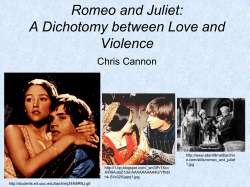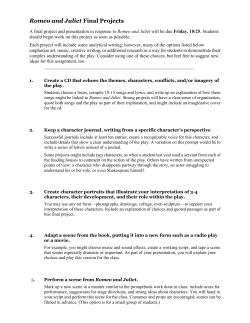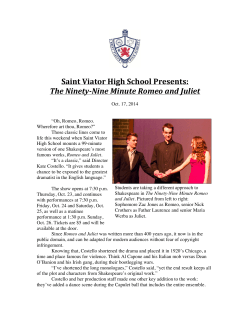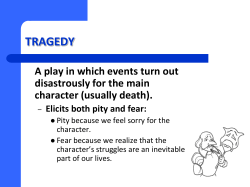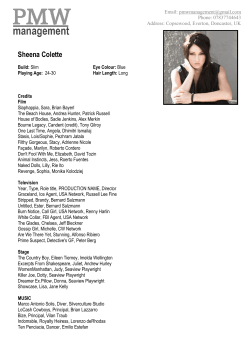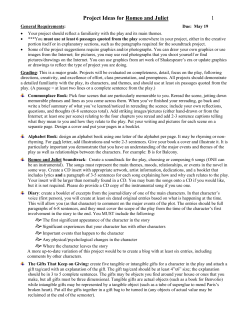
Creative Section 3
Section 3
Creative
Shakespeare
Often we study Shakespeare as big ‘L’ literature. We think of
him as someone who captured important ideas about life - and
the point of studying his plays is to attempt to understand these
big ideas. While Shakespeare certainly had plenty of insight
into the human condition, he was, apart from anything else a
master of turning B-grade schlock into quality entertainment. At
any secondary level, Shakespeare can be used as a model for
the creative process with students. Students can explore his stories, the methods he used to develop them and use these same
techniques in their own creative efforts.
• Taking stories which exist - and improving them:
It will interest students to know that the greatest playwright in
English never came up with an original plot. Every play he
wrote is based on a story which existed already. Students might
study excerpts from a play such as Hamlet, Macbeth or Romeo
and Juliet and then compare the play to its source story. The
tragedies are particularly good to compare to their source material because students can easily see that Shakespeare was
very keen on upping the excitement ante in two basic ways:
more violence and more deaths. Consider the chart below
which compares Romeo and Juliet to its source material
Romeus and Juliet:
Deaths in Romeo and Juliet
Deaths in Romeus and Juliet
Romeo
Romeo
Juliet
Juliet
Tybalt
Tybalt
Paris
-
Mercutio
-
Lady Montague
-
So that’s 100% more deaths in Shakespeare’s play than in the
original source material.
The idea of course is that deaths heighten the tragedy, emotion
and passion of the play - making it much more enthralling for
the audience.
Shakespeare changed the source material in other ways, too.
He introduced new characters that added interest or excitement
to some scenes (and who could die) and changed details to
add drama. Mercutio is a new character in Romeo and Juliet for
7
example, and Shakespeare changes Juliet’s age form 16 to 13
- her youth dramatically underpinning the predicament she is in
the courage she shows.
In considering this creative process, students might also think
about how Shakespeare’s plays have been represented and
changed in the 20th and 21st century on film. For example, in
Baz Lurhmann’s version of Romeo and Juliet, he has Juliet
awakening just as Romeo is dying. For one fleeting moment
both are alive as the magnanimity of the tragedy dawns upon
each of them. This is not how Shakespeare’s play ends - but
the tragedy of the moment is significantly heightened by Luhrmann.
Once you have studied Shakespeare’s process of adapting and
modifying stories, students can have a go at doing this themselves. If you have studied excerpts from one play in particular
(once again a tragedy such as Othello, Macbeth, Romeo and
Juliet, Hamlet or Julius Caesar is highly recommended), students can have their own go writing a synopsis of a film treatment of the play. What details would they include or change to
heighten the tragedy of the play?
Alternatively, students can ‘Shakespearise’ an existing nonShakespearean story. They can begin with a heading such as:
More passion, more action, more deaths: Shakespeare’s....
• Titanic
• Snakes on a plane
• Sleeping Beauty
• [Insert story of your choice]
The task of students after this is to write a one page synposis of
what they would do in a film version to change this story in a
way Shakespeare would to heighten the excitement level.
• Inventing words
One of the reasons teachers frequently trot out to students
about why they should care about Shakespeare is that he was
such an innovator in the English language. Under his penmanship, English experienced a quantum leap. Depending on which
authority you refer to, he is responsible for 2000 to 3000 new
words (or at least first recorded instances of word usage) in the
English language (see a list here:
http://www.shakespeare-online.com/biography/wordsinvented.h
tml). To put that in context, that’s nearly 10% of the average person’s vocabulary. And since Shakespeare only used about
17,000 different words in his plays, that means nearly 20% of
them were new. Shakespeare, then, makes an ideal study for a
unit on ‘Changing English’ where students look at how English
continuously changes and how some things have at different
times significantly impacted on English: Shakespeare is one ex8
ample, technology and globalisation are other examples. In a
unit such as this we might specifically look at how Shakespeare
invented new words. There are several ways he did this:
• Using nouns as verbs and verbs as nouns, and either as adjectives ('Julius Caesar, I Who at Phillipi the good Brutus
ghosted' and 'Destruction straight shall dog them at the heels'
• Creating new compound words (snow-white, fancy-free, eyeball, leap-frog, blood-stained)
• Creating new words by using words from other languages (frugal, horrid, obscene)
All of these techniques we use now. For example, Google is a
noun (a proper noun) - but we have started to use it as a verb:
‘I’m going to google Shakespeare tonight’. We create new compound nouns all the time to label new technology or the consequences of that new technology:
• Road rage
• Cyber bullying
• Media frenzy
Students can learn about the role of Shakespeare in changing
English (this video is a good resource to start with:
http://www.youtube.com/watch?v=rexKqvgPVuA) and be inven-
tive like Shakespeare and create new words. Here’s one strategy to do it:
1. Divide students into pairs
2. Give each pair member ten slips of paper
3. Each individual student needs to brainstorm five concrete
nouns on five separate slips of paper
4. Each individual student then needs to brainstorm five abstract nouns on five separate pieces of paper
5. The pair should then spread out their slips of paper so they
both can see all the nouns they have brainstormed.
6. Students should now create compound nouns by matching
two nouns together. Tell students: ‘we’re not trying to create
real nouns - we’re trying to create the most interesting combinations we can.’ Advise students that interesting compound
nouns can often be created by pairing an abstract noun (such
as murder) with a concrete noun (such as chips) so we get
murder chips. However, interesting nouns can also be created by pairing two concrete or two abstract nouns.
7. At the end of this, ask students to share their most interesting
creations.
9
© Copyright 2025
